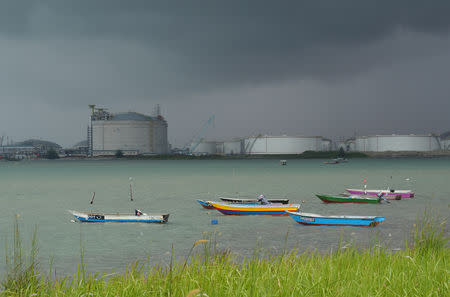Asia's weakening economies, record supply threaten to create oil glut
By Henning Gloystein
SINGAPORE (Reuters) - Oil traders' worries over record supplies arriving in Asia just as the outlook for its key growth economies weakens have pulled down global crude benchmarks by a quarter since early October.
Ship-tracking data shows a record of more than 22 million barrels per day (bpd) of crude oil hitting Asia's main markets in November, up around 15 percent since January 2017, and an increase of nearly 5 percent since the start of this year.
GRAPHIC: Seaborne oil supply to Asia png, https://tmsnrt.rs/2PrQngh
Much of this oil was ordered ahead of U.S. sanctions against Iran that were imposed this month, as refiners prepared for a sudden drop in supply.
But with unexpectedly broad exemptions granted by Washington that allow Asia's main oil consumers to continue buying crude from Iran, the overall supply drop has not materialised.
Global supply has instead surged, led by soaring output from the world's three-biggest producers - the United States, Russia and Saudi Arabia - who in October broke through joint output of 33 million bpd for the first time, meeting more than a third of total oil consumption.
GRAPHIC: Russian, U.S. & Saudi crude oil production, https://tmsnrt.rs/2CTwqaq
That surge has so far been met by healthy demand, not only in Asia's main emerging economies of China and India, but also in the mature markets of Japan and South Korea.
Now, though, the rising supplies are threatening to turn into a glut, triggering a 25 percent sell-off in spot crude contracts since early October as financial traders pulled money out of oil markets.
Analysts warn the situation may get worse, with increasing signs of a slowdown across Asia's biggest economies.
"Momentum still appears to be slowing across the region, reflecting a combination of tighter financial conditions and slowing global trade," said Frederic Neumann, co-head of economic research for Asia at HSBC in Hong Kong.
ECONOMIC U-TURN
China, Asia's biggest economy, may see its first fall in car sales on record in 2018 as consumption is stifled amid a trade war between Washington and Beijing.
In Japan, the economy contracted in the third quarter, hit by natural disasters but also by a decline in exports amid the rising protectionism that is starting to take its toll on global trade.
And in India, a plunging rupee has resulted in surging import costs, including for oil, stifling purchases in one of Asia's biggest emerging markets. India's car sales are also set to register a fall this year.
"While over the past few months, the focus was on the Iran embargo and Venezuela's output struggles, i.e. the risks of too little supply, the market now increasingly looks concerned about the prospects of too much supply," said Norbert Ruecker, head of commodity research at Swiss bank Julius Baer.
"Hedge funds and other speculative money have swiftly changed from the long to the short side," he said.
GRAPHIC: China & India car sales, https://tmsnrt.rs/2PsZ1uW
As recently as September and October, leading oil traders and analysts were forecasting oil prices of $90 or even $100 a barrel by year-end.
Since then, there has been a dramatic shift in sentiment that has turned the entire forward curve for crude oil upside down.
Spot prices in September were significantly higher than those for forward deliveries, a structure known as backwardation that implies a tight market as it is unattractive to put oil into storage.
By this week, the curve had flipped into contango, when crude prices for immediate buys are cheaper than those for later dispatch. That implies an oversupplied market in which it is attractive to store oil for later sale.
HSBC's Neumann said the outlook heading into 2019 remained downcast: "Economic activity continues to decelerate, which likely curtails underlying energy demand growth for a while."
GRAPHIC: Brent curve in Sept vs Nov, https://tmsnrt.rs/2QALtKe
(Reporting by Henning Gloystein; Editing by Tom Hogue)

 Yahoo Finance
Yahoo Finance 


